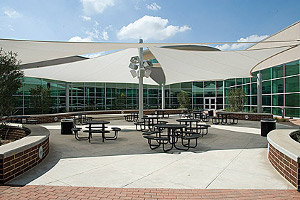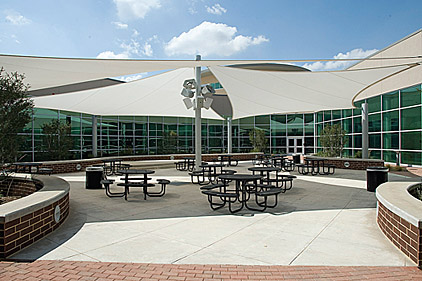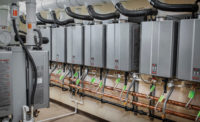
|
|
Tankless water heaters saved the Burleson Texas Independent School District $516,000 in operating costs in one school alone. |
The newest of these projects is also the largest and most complex: the 550,000-sq-ft Centennial High School in Burleson, about 12 miles due south of Fort Worth. Centennial’s hot-water delivery strategy features three multi-unit systems, encompassing a total of 25 tankless water heaters from Noritz America. These units feed food-service and culinary kitchens as well as locker-room sinks and showers in the main building; plus locker room facilities in the adjacent, standalone, indoor-practice field house.
A commitment to maximizing energy efficiency helped spur BISD’s move to tankless in 2009 with the construction of Clinkscale, one of 10 elementary schools in the district. As Holden notes, that commitment is also why Clinkscale, Centennial, and the Academy at Nola Dunn — the third new-construction project in recent years to use tankless — feature an assortment of green construction materials and methods. Among the most im-portant: ground source, or geothermal, heat pump technology from either Florida Heat Pumps (Centennial and Nola Dunn) or Climatemaster (Clinkscale) for space heating and cooling, rather than conventional heating and cooling systems.
“At 97,000 sq ft, Clinkscale is identical in size and layout to our Frazier school,” says Holden, offering the district’s economic rationale for sustainability. “But its annual operating costs are nearly $16,000 less because of its use of tankless water heaters and geothermal HVAC, rather than gas-fired boilers and rooftop air conditioners. That’s a sizable savings, and that’s why we have continued to use these technologies in our building projects.”
Construction on the $117.5 million Centennial project began in June 2008 and finished in the fall of 2010. Situated on a 152-acre site, Centennial has a capacity of 2,000 students at four grade levels.
Fort Worth-based Century Mechanical Contractors, Inc. (CMC) handled the plumbing and HVAC work at Centennial as well as at Clinkscale and the Academy. BISD and general contractor Charter Builders of Dallas chose CMC because of the latter’s expertise in geothermal systems, having completed more than 60 such projects in the Dallas-Fort Worth metroplex over the past 16 years. CMC subsequently was also given the nod to handle the three, 25-unit tankless installations.
THREE HOT WATER SYSTEMS
The size and floor plan of the main structure at Centennial are large and complicated enough to warrant three separate hot-water zones, explains CMC project manager Chad Kroeker, P.E.
Zone 1 – Kitchen facilities:Extending from the building’s circular hub are four different wings. Three house classrooms, and in one of these is the culinary arts kitchen for teaching. Contained within the hub is the cafeteria and food-service kitchen for preparing student meals. Close by — so the hot water need not travel far — are six gas-fired, high-efficiency condensing tankless water heaters with an efficiency rating of 93% and gas inputs of 199,000 Btuh. A dedicated system controller, located in the same space, maintains a constant output temperature, independent of the usage. Venting was done with flexible 4-in. PVC pipe.
Zone 2 – Gym wing locker rooms:The fourth wing of the main building contains the school gymnasiums and their adjoining locker rooms. These receive hot water from a mechanical room on the mezzanine level of this wing where nine, gas-fired tankless units with inputs up to 380,000 Btuh are linked together and also operated by a single controller. Because the nine tankless heaters are conventional atmospheric units, venting consists of 5-in., Category III Stainless Steel.
The school district understandably wanted to minimize the wait at the tap and shower head by bringing the hot-water lines as close as possible to the outlet. Consequently, a 600-ft loop of 3-in. copper pipe was built to connect the plumbing fixtures to the nine-unit tankless system. The system sits idle until the temperature of the water in the loop drops below a preset level, at which point the controller activates a circulator to begin pumping hot water from the tankless system. The number of units firing at any one time depends on the number of showers and faucets in operation.
Zone 3 – Restrooms:Seventy-five, electric point-of-use instantaneous water heaters, made by Stiebel Eltron, serve the various restroom facilities in the other three wings of the school. For the most part, each POU unit is connected to a single sink; however, wherever sinks are positioned back-to-back with a contiguous wall in between, a double-sized unit will be used to generate hot water for both.
Holden made the decision to use POU technology for a couple of reasons, he says that hot-water demand, which is confined to handwashing at the restroom sinks, would be very light and intermittent.
The third tankless water heating system is located the nearby indoor practice facility and consists 10 Noritz, 380,000 Btuh units. Once again, 5-in. stainless steel was used to build the vent runs.
“The tankless and the point-of-use systems are a major improvement over the old ways of bringing hot water to wherever it is needed,” says Holden. “They don’t take up nearly as much space, and they don’t waste energy creating hot water when there is no demand for it.”
Meanwhile, the system sits idle at night, over weekends and holidays — as it should — saving energy by not generating hot water when none is needed.
Kroeker has a rooting interest in BISD’s sticking with tankless, and not just because of the work it brings to CMC. He’s also a resident of Burleson, he says. “As a taxpayer, I like to see lower operating costs, so I definitely like the decision to go tankless.”







